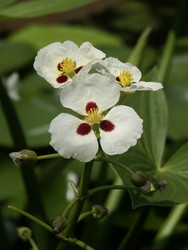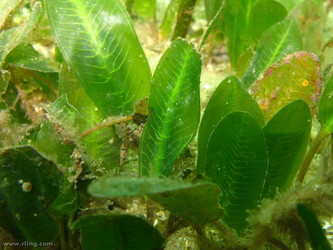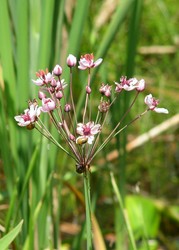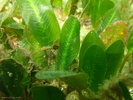Alismatanae
William J. Hahn


This tree diagram shows the relationships between several groups of organisms.
The root of the current tree connects the organisms featured in this tree to their containing group and the rest of the Tree of Life. The basal branching point in the tree represents the ancestor of the other groups in the tree. This ancestor diversified over time into several descendent subgroups, which are represented as internal nodes and terminal taxa to the right.

You can click on the root to travel down the Tree of Life all the way to the root of all Life, and you can click on the names of descendent subgroups to travel up the Tree of Life all the way to individual species.
For more information on ToL tree formatting, please see Interpreting the Tree or Classification. To learn more about phylogenetic trees, please visit our Phylogenetic Biology pages.
close boxIntroduction
The pondweeds and relatives are almost exclusively aquatic or marine and show numerous specializations for this habitat. Many of these features are reductions in form which have confounded attempts at phylogenetic resolution for the group (Dahlgren and Rasmussen, 1983; Les and Haynes, 1995). The superorder includes 15 families, 56 genera, and approximately 500 species.
Characteristics
Morphological synapomorphies for the alismatids include presence of intravaginal squamulae, lack of an endosperm, and root hair cells shorter than epidermal cells. (Dahlgren and Rasmussen, 1983; Dahlgren et al, 1985; Dalgren and Bremer, 1985).
Discussion of Phylogenetic Relationships
This reconstruction is taken from Les and Haynes (1995) and is based on rbcL data.
References
Dahlgren, RMT & K Bremer. 1985. Major clades of the angiosperms. Cladistics 1: 349-368.
Dahlgren, RMT, HT Clifford, & PF Yeo. 1985. The Families of the Monocotyledons. 520 pp. Springer-Verlag, Berlin.
Dahlgren, RMT, & F Rassmussen. 1983. Monocotyledon evolution. Characters and phylolgenetic estimation. Evol. Biol. 16: 255-395.
Les, DH & RR Haynes. 1995. Systematics of subclass Alismatidae: A synthesis of approaches. pp 353-377 in PJ Rudall, PJ Cribb, DF Cutler, & CJ Humphries (eds). Monocotyledons: systematics and evolution. Royal Botanic Garden, Kew.
Title Illustrations

| Scientific Name | Sagittaria montevidensis |
|---|---|
| Location | cultivated at Fairchild Tropical Botanic Garden, Miami, USA |
| Specimen Condition | Live Specimen |
| Body Part | flowers |
| Source | Sagittaria montevidensis male |
| Source Collection | Flickr |
| Image Use |
 This media file is licensed under the Creative Commons Attribution License - Version 2.0. This media file is licensed under the Creative Commons Attribution License - Version 2.0.
|
| Copyright | © 2005 Scott |
| Scientific Name | Halophila ovalis |
|---|---|
| Location | Fly Point, Port Stephens, New South Wales, Australia |
| Specimen Condition | Live Specimen |
| Source | Broadleaf Seagrass |
| Source Collection | Flickr |
| Image Use |
 This media file is licensed under the Creative Commons Attribution-NonCommercial-ShareAlike License - Version 2.0. This media file is licensed under the Creative Commons Attribution-NonCommercial-ShareAlike License - Version 2.0.
|
| Copyright | © 2007 Richard Ling |
| Scientific Name | Butomus umbellatus |
|---|---|
| Location | Ithaca, New York, USA |
| Specimen Condition | Live Specimen |
| Body Part | flowers |
| Source | Prettiest rush ever... |
| Source Collection | Flickr |
| Image Use |
 This media file is licensed under the Creative Commons Attribution-NonCommercial-ShareAlike License - Version 2.0. This media file is licensed under the Creative Commons Attribution-NonCommercial-ShareAlike License - Version 2.0.
|
| Copyright | © 2007 Jenn Forman Orth |
About This Page
William J. Hahn

Georgetown University, Washington, D. C., USA
Correspondence regarding this page should be directed to William J. Hahn at
wjh22@georgetown.edu
Page copyright © 1997 William J. Hahn
 Page: Tree of Life
Alismatanae.
Authored by
William J. Hahn.
The TEXT of this page is licensed under the
Creative Commons Attribution-NonCommercial License - Version 3.0. Note that images and other media
featured on this page are each governed by their own license, and they may or may not be available
for reuse. Click on an image or a media link to access the media data window, which provides the
relevant licensing information. For the general terms and conditions of ToL material reuse and
redistribution, please see the Tree of Life Copyright
Policies.
Page: Tree of Life
Alismatanae.
Authored by
William J. Hahn.
The TEXT of this page is licensed under the
Creative Commons Attribution-NonCommercial License - Version 3.0. Note that images and other media
featured on this page are each governed by their own license, and they may or may not be available
for reuse. Click on an image or a media link to access the media data window, which provides the
relevant licensing information. For the general terms and conditions of ToL material reuse and
redistribution, please see the Tree of Life Copyright
Policies.
Citing this page:
Hahn, William J. 1997. Alismatanae. Version 01 January 1997 (under construction). http://tolweb.org/Alismatanae/21329/1997.01.01 in The Tree of Life Web Project, http://tolweb.org/











 Go to quick links
Go to quick search
Go to navigation for this section of the ToL site
Go to detailed links for the ToL site
Go to quick links
Go to quick search
Go to navigation for this section of the ToL site
Go to detailed links for the ToL site